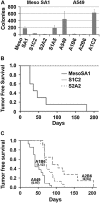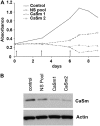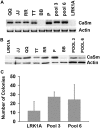CaSm (LSm-1) overexpression in lung cancer and mesothelioma is required for transformed phenotypes
- PMID: 18218995
- PMCID: PMC2396246
- DOI: 10.1165/rcmb.2007-0205OC
CaSm (LSm-1) overexpression in lung cancer and mesothelioma is required for transformed phenotypes
Abstract
CaSm (cancer-associated Sm-like) was originally identified based on elevated expression in pancreatic cancer and in several cancer-derived cell lines. It encodes a 133-amino acid protein that contains two Sm motifs found in the common snRNP proteins and the LSm (like-Sm) family of proteins. Lung tumors and mesotheliomas express high levels of CaSm mRNA and protein compared with adjacent nontumor and normal lung tissue, measured by immunohistochemistry, qRT-PCR, and Western blot analyses. In addition, several human lung cancer- and mesothelioma-derived cell lines have elevated CaSm expression. Two cell lines, transfected with and expressing antisense CaSm RNA, demonstrate altered transformed phenotypes, reducing their ability to form colonies in soft agar and tumors in SCID mice. Furthermore, RNAi-mediated reduction of CaSm RNA and protein is associated with inhibition of cellular growth. These data support the model that elevated CaSm expression in epithelial tissue contributes to the transformed state. Cell lines expressing exogenous CaSm also exhibit transformed characteristics, including increased anchorage-independent colony formation and tumor growth. Thus, the results of loss of function and gain of function studies presented both indicate that CaSm functions as an oncogene in the promotion of cellular transformation and cancer progression.
Figures





References
-
- Jemal A, Siegel R, Ward E, Murray T, Xu J, Thun MJ. Cancer statistics, 2007. CA Cancer J Clin 2007;57:43–66. - PubMed
-
- Jett JR, Miller YE. Update in lung cancer 2005. Am J Respir Crit Care Med 2006;173:695–697. - PubMed
-
- Visbal AL, Williams BA, Nichols FC III, Marks RS, Jett JR, Aubry MC, Edell ES, Wampfler JA, Molina JR, Yang P. Gender differences in non-small-cell lung cancer survival: an analysis of 4,618 patients diagnosed between 1997 and 2002. Ann Thorac Surg 2004;78:209–215. (discussion 215). - PubMed
-
- Henschke CI, Yankelevitz DF, Libby DM, Pasmantier MW, Smith JP, Miettinen OS. Survival of patients with stage 1 lung cancer detected on ct screening. N Engl J Med 2006;355:1763–1771. - PubMed
-
- Bach PB, Jett JR, Pastorino U, Tockman MS, Swensen SJ, Begg CB. Computed tomography screening and lung cancer outcomes. JAMA 2007;297:953–961. - PubMed
Publication types
MeSH terms
Substances
Grants and funding
LinkOut - more resources
Full Text Sources
Medical
Molecular Biology Databases

